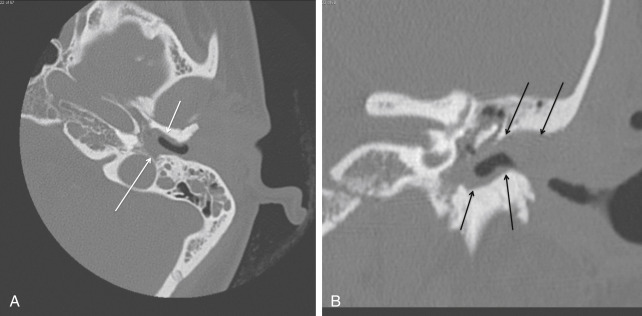Physical Address
304 North Cardinal St.
Dorchester Center, MA 02124
I thank Nancy Verpoort who spent a considerable amount of time editing the figures and texts.
In a wide variety of inflammatory and infectious diseases of the temporal bone, imaging studies are used to determine the extent of the disease and to visualize eventual complications. Imaging protocols for the evaluation of infections in the external ear, the middle ear (and mastoid), and the inner ear are somewhat different, and the interpretation of the images must be done from different viewpoints. In some situations, CT or MRI is the best choice; in others, both techniques are used for different reasons.
External otitis is common and can be caused by exposure to polluted water, after trauma (e.g., after the use of cotton swabs), and in a variety of dermatologic diseases. The ear is painful and itches. Diagnosis is in most cases easy, just by inspection or rarely by using an otoscope. Only occasionally imaging is required. On CT, external otitis is seen as a narrowing of the external ear canal that contains a soft tissue opacification ( Fig. 5.1 ). Purely on the basis of imaging the finding is aspecific and cannot be distinguished from any soft tissue obliteration of another origin.

Necrotizing external otitis, also referred to as malignant external otitis, is a severe infection almost exclusively caused by Pseudomonas aeruginosa . The term “malignant” has also been used because of the aggressive behavior of the disease, rapidly spreading from the external ear canal to the ipsilateral deeper soft tissues and bony structures, such as the mastoid, temporomandibular joint, and parotid gland, but the disease can even proceed as far as in the parapharyngeal space or end up as an extensive zone of osteomyelitis of the skull base, rarely with intracranial extension. Necrotizing external otitis is almost exclusively seen in the diabetic or immunocompromised patient, sometimes in the elderly. Besides local signs of external ear inflammation with otorrhea, ototalgia is the most common symptom.
CT and MRI are both able to visualize the disease, but MRI is superior to provide a detailed view on the exact extent of the disease. On CT, opacification of the external ear canal is seen, as well as bony erosion and destruction of the canal walls and mastoid, and eventually the temporomandibular joint or deeper parts of the skull base, such as the clivus. Pathologic enhancement of the soft tissues surrounding the temporal bone is present, and in more pronounced stages of the disease abscess formation occurs. On MRI the same disease pattern is recognized, but a better contrast resolution leads to a better delineation of the soft tissue changes ( Fig. 5.2 ). Bone marrow changes are also well appreciated on MRI. The most common finding on MRI is infiltration of the fat behind the mandibular condyle. Treatment consists of a combination of surgery with intravenous antibiotics.

Become a Clinical Tree membership for Full access and enjoy Unlimited articles
If you are a member. Log in here